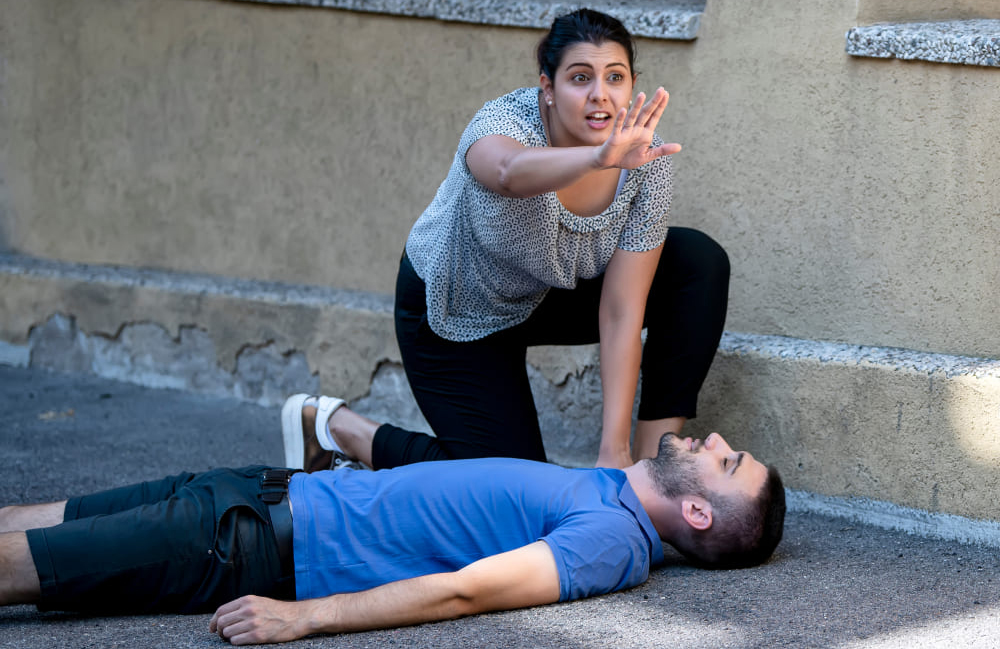


Every day, countless individuals face the abrupt silence of a heart that stops, often without warning, leaving life hanging in a delicate balance.
Amidst this fragility, there emerges an opportunity for ordinary individuals standing by to become extraordinary champions. Turning a stopped heart back into a life-sustaining rhythm doesn’t always require a medical degree. Often, it may just require a ready will and some basic knowledge of emergency action.
The transformation from an ordinary onlooker to a Heartstrong Hero, capable of reviving life, hinges on the power of training in Cardio Pulmonary Resuscitation (CPR).
As we delve deeper into this blog post, we’ll explore the profound impact of this CPR skill – and the pivotal role each of us can play in the crucial moments between life and death for those affected.
Cardiac arrest can emerge as an unseen enemy, striking at any time without warning. According to the American Heart Association (AHA), over 350,000 out-of-hospital cardiac arrests occur annually in the United States alone. Disturbingly, a mere 10%-25% of these victims survive.
But there’s a glimmer of hope amidst such sobering figures.
The chances of survival can double or even triple if the victim receives CPR from a person nearby before medical help arrives. Yet, statistics show that less than one-third of those who suffer a cardiac arrest outside a hospital receive this potentially life-saving intervention.
This disparity underscores the critical need for immediate CPR. This simple yet imperative skill bridges the gap between life and a tragic outcome until professional medical care can take over.
When an individual suddenly collapses amidst the buzz of daily life, though dozens of watchers may surround the person, an eerie hesitation lingers in the air. According to Kendra Cherry, MSEd, writing in Very Well Mind, this perplexing inaction is rooted in the phenomenon known as the Bystander Effect.
Psychologists define this as the tendency for individuals to be less likely to offer assistance in emergencies when other people are present. What is the underlying logic? There is, apparently, a “diffusion of responsibility.”
In common terms, that means we often believe, consciously or subconsciously, that someone else in the crowd will step up – or perhaps that someone else might be more qualified to intervene. This results in a paradox where the more witnesses there are, the less likely anyone is to react swiftly and decisively.
Recognizing and confronting this innate psychological response is the first step to ensuring we don’t remain passive spectators in critical moments. We have to be that spark that lights up others to act along with us – that proverbial “Zinda Dil.”
Time is always of the essence, but never more so than during a cardiac arrest. The heart stops beating, blood circulation ceases, and every passing second presents diminishing hope.
During these literally heart-stopping moments, the brain begins to suffer from a lack of oxygen, and irreversible damage can occur in as little as four to six minutes.
When CPR is initiated without delay, it acts as a temporary lifesaver, maintaining the flow of vital blood to the brain and heart. When a trained person in the vicinity jumps into action with CPR, they can double or even triple a victim’s odds of survival.
According to Cleveland Clinic, if, during the first 8-10 golden minutes immediately after heart stoppage, the missing heartbeats are bridged by rhythmic chest compressions given via CPR, they can make all the difference between life and irreversible loss.
When confronted with the daunting reality of a life hanging in the balance, hesitation and self-doubt can be our greatest adversaries.
However, with CPR training, individuals are equipped with both – a skill and the confidence that accompanies it. Understanding the mechanics of resuscitation, recognizing the signs of cardiac arrest, and knowing the rhythm of chest compressions can transform an overwhelming situation into a calm and structured response.
According to Francesca Coltrera, writing in Harvard Health Publishing, CPR training is more than just a set of techniques; it’s also an empowerment tool that gives individuals a profound ability to make a tangible difference in critical moments.
CPR knowledge demystifies the process, turning what might seem like a complex medical procedure into a sequence of steps anyone can execute. CPR training also elevates reluctant individuals into proactive lifesavers who understand the importance of timely intervention.
According to Psychology Today, the Bystander Effect stymies the general crowd watching the goings-on because of “collective ambiguity”. No one knows who is going to act. But how can we shatter this mass indecision and turn passive observers into proactive saviors?
Training in CPR serves as both a tool and a catalyst to help with such situations of collective inaction. With the mastery of this lifesaving skill comes a heightened sense of responsibility and a keen awareness of one’s capability.
This blend of knowledge and empowerment acts as an antidote to the paralyzing effect on the crowd. When one individual steps forward, it can create a domino effect, inspiring and encouraging others to follow suit.
In the face of life-threatening emergencies, breaking free from the non-participative mode isn’t just an individual act of bravery. It’s a call to group action, challenging everyone to rise above their passivity and embrace their potential as life savers.
Cardiac emergencies can happen to anyone, but each of us has the ability to make a difference. Armed with CPR knowledge, we can transition from mere reticent spectators to ready life savers. Committing to regular training, prompt action in emergencies, and spreading awareness – these three mandates can transform us and fortify our communities.
So, don’t let yourself just be a witness in a medical emergency. Actively choose to champion a life-saving cause. Become a Heartstrong Hero.